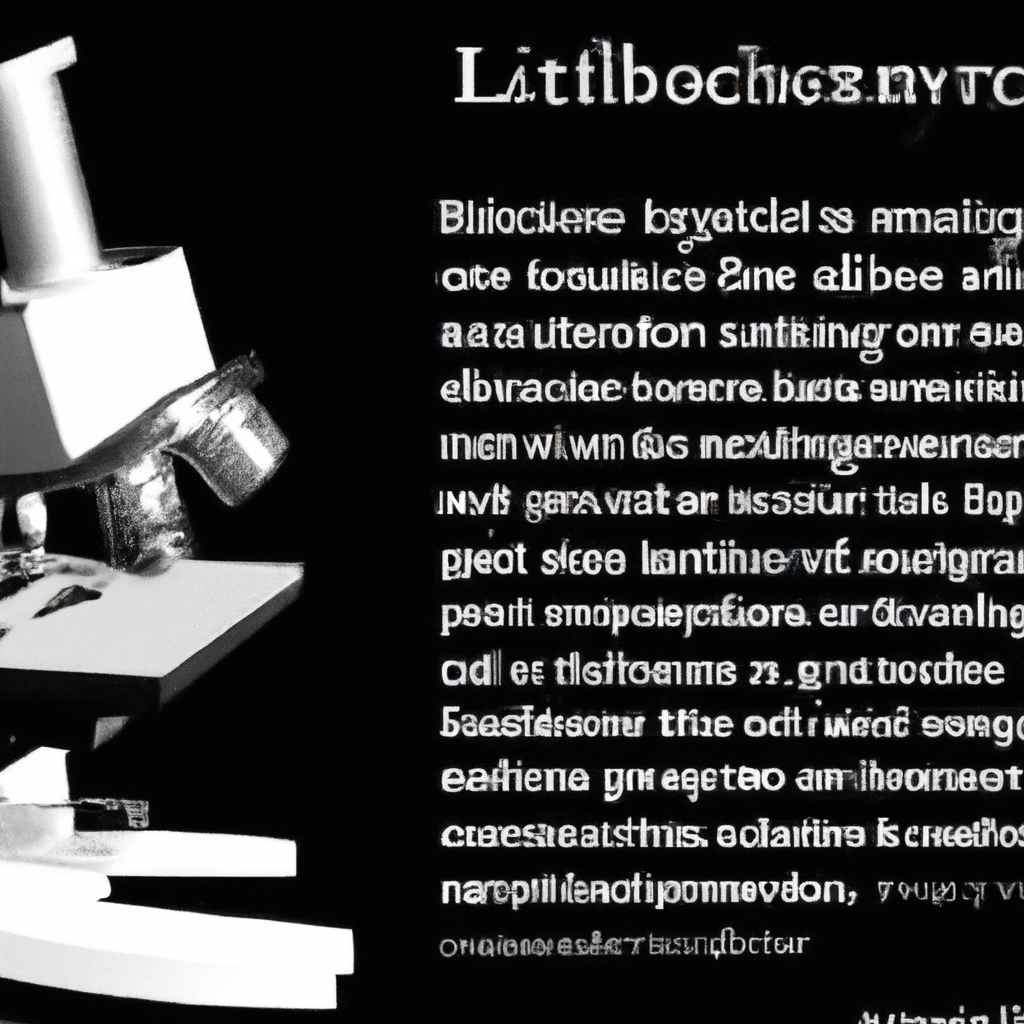Do you ever wonder about the limitations of light microscopes? Well, it turns out that they do have a main disadvantage. While these microscopes have been incredibly useful in the field of science, allowing us to observe and study various samples, they do have their limitations. One major drawback is their inability to achieve high resolution. Due to the nature of light itself, light microscopes cannot distinguish tiny details or structures that are smaller than the wavelength of visible light, resulting in blurred images. As technology advances, scientists are continually seeking ways to overcome these limitations and push the boundaries of what we can observe using light microscopes.

Limited resolution
Diffraction limit
One of the main disadvantages of using light microscopes is limited resolution. This refers to the microscope’s ability to distinguish between two closely spaced objects as separate entities. Light microscopes are limited by the diffraction limit, which is determined by the wavelength of the light used. According to the Rayleigh criterion, the resolution of a light microscope is approximately half the wavelength of the light. As a result, it is difficult to visualize fine details or structures that are very close together.
Poor resolution for smaller objects
Furthermore, light microscopes have poor resolution when it comes to observing smaller objects. Due to the longer wavelength of visible light, it becomes more challenging to visualize tiny structures or features on a microscopic level. This limitation can hinder the study of cellular organelles, nanoscale particles, or other minute components. In such cases, more advanced microscopy techniques, such as electron microscopy, may be necessary to overcome these limitations and achieve higher resolution imagery.
Limited magnification
Physical limitations
Another notable disadvantage of light microscopes is limited magnification. While magnification is an essential aspect of microscopy, light microscopes have physical constraints that restrict the achievable magnification levels. The maximum usable magnification typically ranges between 1000x and 2000x for most light microscopes. Beyond this point, the image quality deteriorates, and the details become less distinguishable. To visualize smaller objects or structures in greater detail, higher levels of magnification provided by electron microscopes or other specialized techniques must be employed.
Increasing magnification without improving resolution
It is important to note that increasing the magnification in light microscopy does not automatically improve the resolution. As discussed earlier, the resolution of the microscope is primarily limited by the diffraction limit. Therefore, increasing magnification without addressing the underlying resolution limitations may result in larger, but still blurry images. This can be problematic when trying to visualize intricate details or when studying samples that require precise examinations.
Inability to visualize certain structures
Lack of contrast
One significant limitation of light microscopes is the inability to visualize certain structures due to a lack of contrast. Some structures within the sample may have a similar refractive index or optical properties, making them challenging to differentiate from the surrounding background. This lack of contrast can obscure important details or make it difficult to distinguish between different components within a sample. Techniques such as staining or labeling with specific dyes can enhance contrast and make certain structures more visible.
Inability to penetrate thick or opaque samples
Light microscopes also face limitations when it comes to visualizing thick or opaque samples. If a sample is too thick or contains materials that significantly block or scatter light, it becomes challenging to observe the structures within it. The depth to which light can penetrate the sample is limited, resulting in incomplete or obscured images. This limitation can impede the study of certain biological tissues, geological formations, or other materials that are naturally opaque or have limited transparency.
Limited ability to visualize specific molecules
Light microscopes have a restricted ability to visualize specific molecules directly. Unlike techniques such as fluorescence microscopy, which can detect specific molecules and their localization within a sample, traditional light microscopy relies on general interactions with the sample. This limitation can hinder analyses that require the identification or tracking of specific molecules or molecular processes.
Limited depth of field
Focusing on a single plane
Light microscopes have a limited depth of field, meaning they can only focus sharply on a single plane at a time. When imaging three-dimensional structures or samples with varying depths, it can be challenging to bring the entire sample into clear focus simultaneously. This limitation often requires multiple images at different focal planes or specialized techniques such as confocal microscopy to create a composite image with extended depth of field.
Difficulty in visualizing three-dimensional structures
Related to the limited depth of field, light microscopes can encounter difficulties in visualizing three-dimensional structures. While stereo microscopes can provide a sense of depth, they have limitations in terms of resolution and magnification. Achieving high-resolution three-dimensional imaging typically requires more advanced techniques, such as confocal microscopy, where optical sections at different depths are combined to reconstruct a three-dimensional image.

Inability to observe living samples
Need for sample fixation
In light microscopy, observing living samples directly is often challenging due to the need for sample fixation. Fixation involves preserving the sample’s structure and preventing biological processes from continuing, allowing for observation at a later time. However, this process can alter the sample’s natural state and introduce artifacts, potentially affecting the accuracy of observations. While techniques like time-lapse microscopy can capture dynamic processes in real-time, they still require specific sample preparation and may have limitations in terms of imaging speed and duration.
Use of stains and dyes
To overcome the limitations of light microscopy when observing living samples, stains and dyes are often utilized. These substances can selectively bind or interact with specific components within the sample, enhancing contrast and making certain structures more visible. However, the use of stains and dyes also introduces potential biases, as they may alter the natural behavior or properties of the sample. Care must be taken to choose appropriate stains and ensure that they do not interfere with the biological processes under investigation.
Limited field of view
Narrow field of vision
Light microscopes typically have a narrow field of vision, restricting the amount of the sample that can be observed simultaneously. This limitation can be particularly challenging when studying large samples or when trying to understand the spatial relationships between different structures within the sample. Panoramic or mosaic imaging techniques can partially address this limitation by stitching together multiple images to create a composite view of a larger area.
Difficulty in studying large samples
In addition to the narrow field of vision, light microscopes face difficulties when studying large samples. The physical size of the sample may exceed the microscope’s stage or objective capabilities, preventing a comprehensive observation. Some techniques, such as slide scanners or virtual microscopy, allow for the automated acquisition and stitching of multiple images to create a high-resolution and wide-field view of the entire sample.
Limitations in sample preparation
Need for sample thinness
Light microscopes often require samples to be thin enough for light to pass through and form an image. This requirement can be challenging when dealing with thick or bulky samples that cannot be easily sectioned or prepared in a thin format. Sample preparation techniques such as slicing, microtomy, or cryosectioning are commonly employed to overcome this limitation and achieve the necessary sample thickness for observation.
Potential artifacts caused by processing
Sample preparation techniques for light microscopy can introduce potential artifacts that may affect the accuracy or reliability of observations. Processing steps like fixation, staining, or dehydration can alter the sample’s structure, composition, or cellular viability. It is crucial to optimize sample preparation protocols and validate the impact of processing steps to minimize any potential artifacts and ensure accurate interpretation of the microscopy data.
Lack of quantitative data
Limited ability to measure accurately
Light microscopes have limited ability to measure accurately and quantify certain features within a sample. While they can provide qualitative information about the sample’s morphology or structure, obtaining precise quantitative data, such as size, distance, or intensity measurements, can be challenging. Techniques like image analysis software or calibration standards can help improve the accuracy of measurements to some extent.
Subjectivity in interpretation
Another limitation of light microscopy is the potential for subjective interpretation of the observed data. Human bias or variability in interpretation can influence the conclusions drawn from the images obtained. Techniques like blind analysis, where the observer is unaware of the sample’s details or experimental conditions, can help reduce subjectivity and improve the reliability of the observations.
Inability to observe fast-paced events
Slow image acquisition
Light microscopes typically have slower image acquisition rates compared to other imaging techniques. Capturing high-quality images can require longer exposure times, resulting in slower imaging speeds. This limitation can be particularly problematic when trying to observe fast-paced events, such as cellular dynamics or rapid changes occurring within the sample. Techniques such as high-speed or time-lapse microscopy can partially overcome this limitation, but they often require specialized equipment and may have inherent trade-offs in terms of image quality or duration.
Inability to capture rapid changes
While light microscopes can capture dynamic processes to some extent, they have limitations in capturing rapid changes. The time required to physically move the stage, refocus, or change imaging settings can introduce significant delays, making it difficult to precisely capture quick or transient events. Techniques like spinning disk confocal microscopy or total internal reflection fluorescence (TIRF) microscopy can provide faster imaging rates, enabling the visualization of more rapid changes in the sample.
Cost limitations
Expensive equipment
Light microscopes, particularly those designed for advanced applications, can be expensive. The cost of a high-quality microscope often includes various components such as the microscope body, objectives, illumination systems, and additional accessories. These expenses can pose challenges for researchers or institutions with limited budgets, hampering access to state-of-the-art microscopy equipment.
Maintenance and operation costs
In addition to the initial equipment cost, light microscopes require regular maintenance and operation expenses. Regular cleaning, periodic servicing, and the replacement of consumables like bulbs or filters can incur additional costs. Moreover, the expertise and training required to operate and maintain the microscope may also necessitate further investment. These ongoing costs and the need for technical expertise can further limit the accessibility of light microscopy for certain individuals or organizations.
In conclusion, while light microscopes have revolutionized our understanding of the microscopic world, they still face several limitations. The restricted resolution and magnification, inability to visualize certain structures or living samples, limited depth of field and field of view, challenges in sample preparation, lack of quantitative data, inability to observe fast-paced events, and cost limitations all contribute to the disadvantages of light microscopy. To overcome these limitations, researchers continuously explore and develop advanced microscopy techniques that allow for higher resolution, better sample visualization, improved quantification, and faster imaging speeds. By understanding these limitations, scientists can make informed decisions when selecting the most appropriate microscopy method for their specific research needs.




